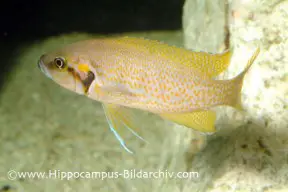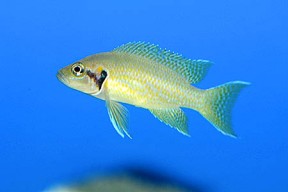Neolamprologus helianthus
Sunflower Lamprologus
Classification
Cichlidae. Subfamily: Pseudocrenilabrinae
Distribution
Endemic to Lake Tanganyika. The type locality is Kamakonde, towards the south end of the lake on the western shore.
Habitat
Rocky parts of the shoreline.
Maximum Standard Length
3.2″ (8cm).
Aquarium SizeTop ↑
30″ x 12″ x 12″ (75cm x 30cm x 30cm) – 70 litres is ok for a single pair.
Maintenance
Should be housed in a Lake Tanganyika biotope setup. Fill the tank with piles of rock, arranged to form caves. A sandy substrate is preferable.
Water Conditions
Temperature: 73-81°F (23-27°C)
pH: 7.5-9.0
Hardness: 8-25°H
Diet
Live and frozen foods should comprise a large proportion of the diet. Dried foods can be fed, but use these less often. Vegetable matter, such as spirulina or blanched spinach should also be offered regularly.
Behaviour and CompatibilityTop ↑
A somewhat aggressive, territorial fish best maintained in a species tank. However, in large tanks it can be kept with other small to medium-sized Tanganyikan cichlids that occupy different areas within the tank such as Cyprichromis sp. Other rockdwellers such as Julidochromis or Altolamprologus sp. are possibilities if the tank is large enough and sufficient territories are provided. It should never be kept with Mbuna or other boisterous species. It is very aggressive towards conspecifics and only a single pair should be kept unless the tank is very large.
Sexual Dimorphism
Not at all easy to sex. Adult males tend to be larger than females.
Reproduction
Possible. Cave spawner. It’s best to start with a group of at least six young fish, allowing these to pair off naturally. The spawning tank should be at least 30″ in length (depending on the size of the initial group) and set up as suggested above. Maintain the pH around 8.2-9.0 and the temperature at 77-80°F. It is far better if no other species are present though it will often spawn in a community situation. Condition the group with a high quality, varied diet as above.
Be prepared for some losses, or at least to remove some of the group, as subdominants will not usually be tolerated. A single dominant pair will then remain, which will stay together for life. They will spawn secretly in a cave which they often excavate themselves, with the female laying her eggs on the wall or roof of it. Once spawning has occured, the female will tend to the eggs while the male guards the area around the cave. It is often difficult to tell if anything has happened until the fry appear. As a general rule, if you suspect there is a brood in the tank, start adding a food source for the fry.
These are large enough to take brine shrimp nauplii from birth but are quite slow growing. As with other Brichardi complex Neolamprologus species, brood care is long-lived and previous generations of fry are permitted to remain with the parents until they reach sexual maturity. The parents will continue to spawn and several generations can often be seen coexisting in the same aquarium.
NotesTop ↑
This stunning species was only described in 1997 and is included in the so-called “Brichardi complex”, which also includes N. brichardi, crassus, falcicula, gracilis, pulcher, savoryi and splendens. The species should not be mixed in aquaria as they will hybridise freely. N. helianthus can be distinguished from others in the complex by its overall yellow-orange patterning and v-shaped cheek marking.



